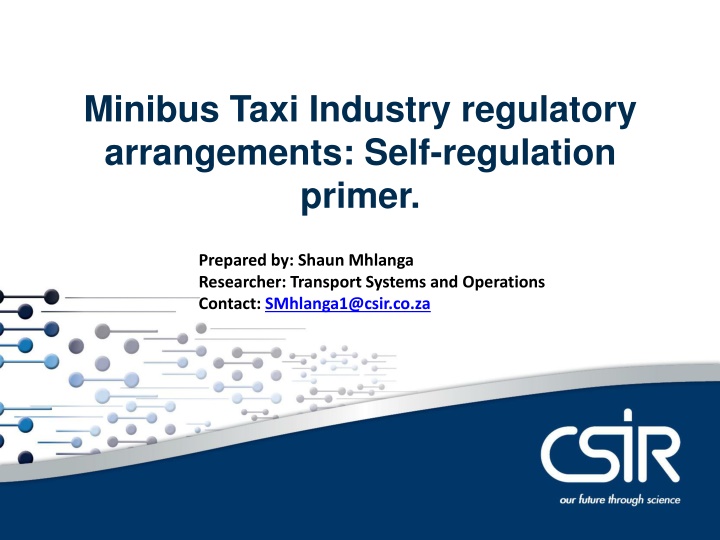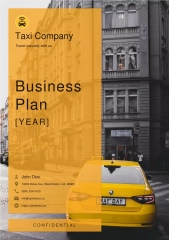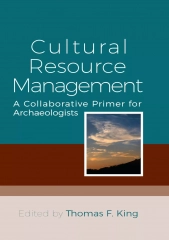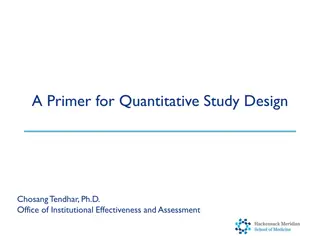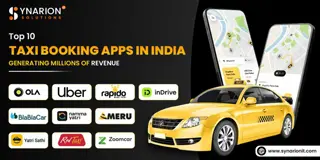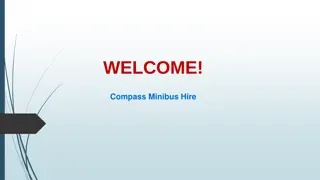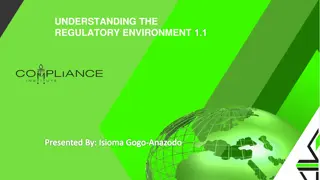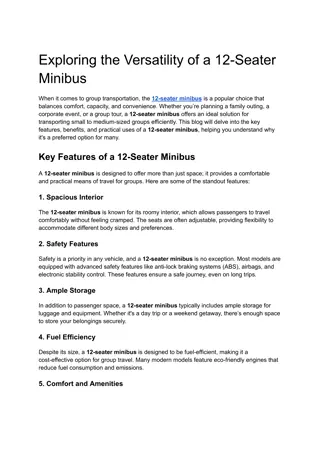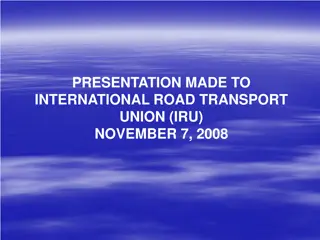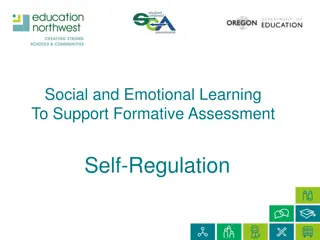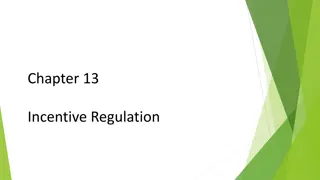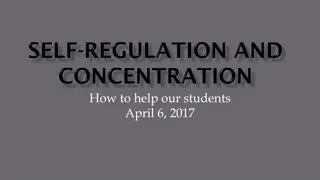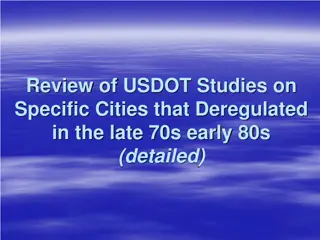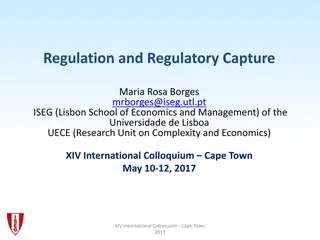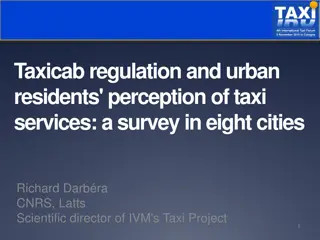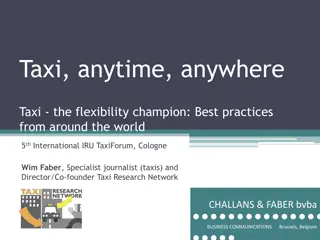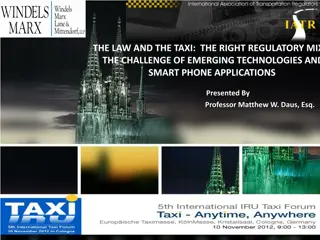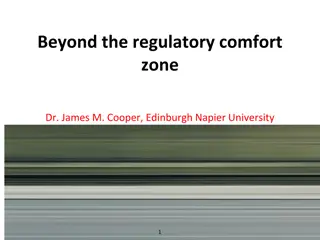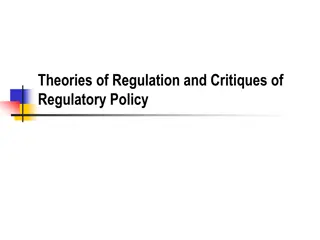Minibus Taxi Industry regulatory arrangements: Self-regulation primer.
Assess current regulation in the minibus taxi industry, explore innovative management forms, and highlight the role of non-government bodies in shaping policy direction through self-regulation. Governance is a fundamental pillar in achieving sustainable outcomes in the transport sector, focusing on mutual interests and market-led systems. The study aims to advance targeted economic reform initiatives and improve user knowledge in road safety and attitudes.
Download Presentation

Please find below an Image/Link to download the presentation.
The content on the website is provided AS IS for your information and personal use only. It may not be sold, licensed, or shared on other websites without obtaining consent from the author.If you encounter any issues during the download, it is possible that the publisher has removed the file from their server.
You are allowed to download the files provided on this website for personal or commercial use, subject to the condition that they are used lawfully. All files are the property of their respective owners.
The content on the website is provided AS IS for your information and personal use only. It may not be sold, licensed, or shared on other websites without obtaining consent from the author.
E N D
Presentation Transcript
Minibus Taxi Industry regulatory SIP arrangements: Self-regulation primer. Prepared by: Shaun Mhlanga Researcher: Transport Systems and Operations Contact: SMhlanga1@csir.co.za
Contents Study aim Introduction Problem statement Current regulatory approach Regulatory challenges Self regulation RTMS Conclusion Thank you
Aim of study Assess current regulation and investigate innovative forms of management and control. Highlight that less is studied about non-government bodies and how such institution facilitate in shaping policy direction. Governance conceived as fundamental pillar in pursuit of sustainable outcomes in the transport sector. Posits a reflection of market led systems where market either cannot or does not know how best to intervene but where there is a set of outcomes that are of mutual interests to be achieved. Intro to Governance aimed at demonstrating that progress in policy is and can be around what people can agree on which is not necessarily what s best but it is what can be done. Thank you
Introduction Road safety and MBT industry regulation Significance advanced i.t.o. road safety being shared responsibility, based on cooperation Human behaviour elements in understanding road traffic problems MBT and Government through the NTTT joint task force identified critical economic, human behaviour and lifestyle related challenges Authorities sought to advance targeted economic reform initiatives, improvement in user knowledge regarding user behaviour, skills, safety and attitudes. Thank you
Introduction & problem statement. Literature on regulatory, institutional and transformation challenges in MBT and broader public transport industry Improving regulation and road safety MBT represents critical pathway to reducing deaths and injuries arising from road accidents. Assessment of potential approaches that aim to respond to the MBT industry and policy challenges from a governance perspective has not been found in literature. Targeted initiatives may be essential component to any strategy aimed at road-based public transport reform and service level improvement. Thank you
How Mini bus taxi markets are currently regulated? Regulatory framework of the minibus industry in RSA Legal restrictions Responsibility for licensing of vehicles No concessions / Provincial authorities / local municipality / TA authority Thank you on Minibus entry to market Licensing board / regulatory agency / local or provincial or System for allocating routes to operators Responsibility for driver & vehicle inspection Traffic department (local or provincial) / none / testing stations Fares regulated VTS, DLTC, None / Some Self regulation national
Regulatory challenges Harmonisation of individual interests (association or route based). South Africa as an extreme case of how ruthless and deadly unregulated Thank you competition can be. Trusting relations between stakeholders. Licensing and route determination process is highly regulated however deviation from the set laws creates problems Market entry (inadequacies in OL issuance) and quality of supply Transparency of decision making and corrupt government officials. Inadequate availability of facilities Absence of evidence based planning and effective law enforcement Illiteracy and lack of operational including administrative control Invasion & encroachment by illegal operators
Self-regulation introduction Transformation of nation-state power and emergence of non-governmental actors between late 80 s and 90 s. Since then, a growing area of interests to help understand: Mechanisms adapted to changes of economic globalization Other changes in the distribution of power and governance structure of international society; and notably Harmonize varied individual interests in the management of collective business interests and common pool resources. Thank you
Self-regulation introduction cont.. A cooperative mode of control where participants engage in mixed networks of interaction Authority from exercise of control and coordination Characterized by high degree of independence from the government however not immune from indirect or imperfect government influence Used to describe different modes of coordinating individual actions or basic forms of social order. In transportation, governance involves processes and systems used to manage collective affairs and activities between state and non-state actors. Thank you
Characteristics of self regulation Demonstration of identifiable and measurable gains from the scheme for stakeholders, New rules must be accompanied by credible enforcement of such rules. i.e. visible verification mechanisms by industry Supportive institutional environment that can enable coordination and complementary arrangements to flourish. Typically, requires adoption of new management practices and enables the establishment of other opportunities i.e. Value system Thank you
Self-regulation models.. It further involves adoption of instruments and methods that promote fair sharing of information and collective responsibility in producing a service. Generally, 4 models of governance in literature Market based (organization of various institutions to develop and implement best practice) Sustainability standards or Voluntary schemes (relies on coordinating power of networks of entities and industry players) Network governance (interfirm coordination characterized by organic or informal social system. similar to voluntary but the network are not hierarchical in structure).Forest Steward Council (FSC) Mixed methods depending on goal pursued Thank you
RTMS Case Study: Filling regulatory gaps in the road freight industry The Road Traffic Management System (RTMS), an industry led initiative responsible for facilitating sustainable truck payloads within confines of legally prescribed load factors. Based on a set of industry-determined standards and manuals to encourage responsible operations and compliance with law. Operator certification programme to demonstrate compliance with legal requirements Companies that have embraced the scheme have demonstrated significantly improved compliance and safety performance. RTMS conceived after growing recognition of the socioeconomic cost and dangers of unsafe practices in the road freight industry. Generally, RTMS is about promotion of good business practices Thank you
RTMS Case Study: Filling regulatory gaps in the road freight industry cont. RTMS is based on established set of operational performance measurement tools that can quantitatively monitor and manage the risks associated with the provision of road freight services. Typically makes use of an internationally recognized road traffic safety certification regime i.e. ISO 39001, as means of gaining legitimacy and certification compliance. As a result, enjoys institutional support from authorities and industry players; and has demonstrable contribution towards (NDoT) National Freight Logistics Strategy objectives, More crucially, advocates for transport operators and other road transport stakeholders to take active responsibility of their respective business behaviour and practices. Thank you
Four Pillars of the RTMS Thank you
RTMS successes that can potentially be leveraged into MBT industry Reduction and minimization of overloading Preventing road damage & preserve infrastructure Enhancing safety of vehicles on roads Driver wellness initiatives Reduction in traffic violation Active promotion of skills development within the transport sector Industry or company measuring respective performance Reduction in crash / incident rates Improved compliance i.t.o. traffic violations, driving hour violations, fewer speed exceptions. Thank you
Pertinent questions going forward Who are the industry stakeholders? Thank you What are stakeholder looking for? What do they get? What do they miss out on?
MBT industry value system. Value added opportun ities Services Thank you - Logistics & Marketing - IT consulting - R&D - Software solutions (Media & Software) - Network Design - Business solutions, platforms and packages - Production - Components manufacturing - Distribution - Equipment and vehicle repair - Freight bus - Components Telecommunicatio ns - Raw materials Supporting industries Supply chain - Financing institutions - SMME's
Conclusion RSA has sophisticated regulatory environment however it needs to be translated to business processes. Need to facilitate learning and improvement through institutions (both state & non-state actors). Development of sustainability schemes can aid better coordination and cooperation of human behavior, other road safety and economic challenges. Institutional learning environment to facilitate sharing of knowledge in industry best practice has been non-existent. Such schemes can draw on a philosophical tradition of community & social solidarity (Ubuntu concept interdependence of human beings) Thank you
Conclusion cont.. Embrace & harness high degree of collective organisation displayed by associations i.e. better & enhanced organisational setting Move away to external relationships of MBT operators from route and association based There exist complementary mechanisms that can potentially assist in escalating targeted improvements in road economic and safety. Thus make systems much more transparent i.e. enable identification of what is on the roads, what is in the pipeline, who owns what, etc. Such mechanisms must be explored whilst promoting value creation for broader stakeholders and enhancing public welfare. Thank you
Thank you Thank you
